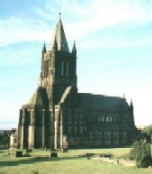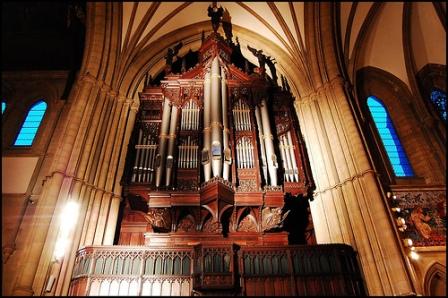-

St. Bartholomew's, Armley
THE SCHULZE FAMILY, & THE ORGAN TRAVELS

|
St. Bartholomew's, Armley THE SCHULZE FAMILY, & THE ORGAN TRAVELS |
|
|
|
|
|
|
|
|
|
|
|
|
|
|
(left)
Front door to the family house. (right) Main door panels,
undoubtedly carved by the family. |
|
|
|
|
|
|
|
|
|
|
|
|
|
|
|
From
left to right: the Schulze Family home, the Finishing Shop |
|
|
|
|
|
|
|
|
|
|
|
|
Meanwood, now a suburb of Leeds, was the site chosen by Thomas Stuart Kennedy for his home. Kennedy, who commissioned the Organ from the Schulze family, built himself a large mansion, known as 'The Towers', the house name no doubt derived from the towering chimney stacks which characterised the building. (It might well have become known as 'The Stumps', since the chimneys were prone to toppling in high winds.) In Kennedy's day, the house would overlook Meanwood Valley, now a dribble of greenery following a small tributary to the River Aire, running from Leeds' green belt down towards the city centre. There would be a strong awareness at the time of the local leather industry, Meanwood being home to one of the city's large tanneries, completed in 1857. Capable of dealing with 70,000 hides at a time, the works along with neighbouring ones at Kirkstall had to import raw materials from as far away as India, since it's demand easily out-stripped the home supply. |
|
|
|
Still standing, the house
looks quite incongruous as it centres a small estate of mid-20th
century housing. No.29, Towers Way, and the full width of roadway
fronting the property, now stand on the site of the former Organ
House. |
|
|
|
|
|
|
|
|
|
|
|
|
|
|
|
|
|
Meanwood Towers, in the mid 20th century. |
Area once occupied by the Organ chalet. |
|
|
|
|
Harrogate |
restriction
to visiting what turned out to be Edmund Schulze's last organ
(the replacement for the one bought for Armley). However, the
instrument can hardly now be labelled as the work of Schulze, as
it has been considerably altered over the years by various
builders, especially in 1952 when it underwent a major re-build,
during which they 'used some old pipework, but also took the
opportunity to extend the instrument'*.
In 1986 they even had two electronic
32
foots added, stepping even further away from the Schulze recipe!
As a contemporary, St.Peter's could hardly be more different from
the Church at Armley, and a visit makes it obvious that in terms
of organ design, what suited one could hardly sound right in the
other. The visitor should also note that Schulze was obliged to
install the Meanwood organ in the wide but stunted South Transept
of St. Peter's, making it remote from the main body of the
Church. It's replacement commands a much better position in the
former vestry area to the south of the chancel.
|
|
|
|
|
|
For details of St.Peter's
Organ restoration programme - www.stpetersharrogate.org.uk
|
|
|
|
|
|
|
|
|
|
|
|
|
|
|
|
|
|
|
|
|
|
|
|
|
Armley, in Leeds, is now described by the loaded term 'inner city'. From no more than a hamlet in the 18th Century, it had grown into a township of around 30,000 people by 1900. This came about purely through industrialisation, marked in Armley's case by many mills, some of which still exist, albeit dormant or serving some other purpose. In its day, towards the end of the 19th Century, Armley was a concentration of back-to-back terraces, with still enough whiff of the country to be home to a number of wealthy industrialists. Before long, these leaders of society were obliged to seek more salubrious out-of-city areas, leaving behind a growing working class population and the embarrassment of abandoned manor houses. For this reason, the Church of St.Bartholomew's now stands out like a sore thumb, above the clutter of modern streets and basic housing. It was the wealth and rivalry of the local notables which lumbered the people of Armley with this cathedral-like edifice (in terms of internal volume it is the largest church in the whole of the Ripon and Leeds Diocese, not counting the cathedral at Ripon itself). Contemporary wealthy jostling adorned the Church with the extravagances of late-Victoriana, fortunately stopping short before all the wall panels were filled with colourful mosaics. While it is a worthy auditorium for the mighty Schulze Organ, the Church is now quite incongruous in the local community, yet it remains as the focal identity for the populace. |
|
|
|
|
|
|
|
|
|
|
A
recent picture of Gott's Park Mansion |
Armley, in common with many other places, if you try hard enough, can be traced back to pre-Domesday times, as the fortified settlement of a Danish chieftain. It really came into its own in the 18th Century, with the arrival of the woollen mills, with Armley Mills being at one time the largest woollen mill in the world. Later, Armley Mills was bought and augmented by Benjamin Gott, the main benefactor of the original church next to the present site of St.Bartholomew's.
|
|
|
|
|
|
|
|
|
|